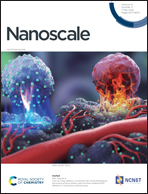Experimental and theoretical study of europium-doped organometal halide perovskite nanoplatelets for UV photodetection with high responsivity and fast response†
Abstract
Herein, we investigate the role of Eu3+ doping on CH3NH3PbBr3 nanoplatelets (NPLs) in terms of their optoelectronic properties and photodetection application through a combined experimental and theoretical approach. The introduction of EuCl3 in the CH3NH3PbBr3 crystal structure by a facile solvothermal method enabled the tuning of the lateral and vertical dimensions of the NSs to form large-area NPLs and finally monolayer nanocrystals. The appearance of low-angle diffraction peaks with Eu doping, which are observed in layered perovskite structures, confirms the formation of quasi-2D NPLs. The bandgap of the Eu-doped mixed halide perovskite systematically increases from 2.39 eV to 2.94 eV with increasing doping concentration. Interestingly, 10 mol% EuCl3 doping in the pure CH3NH3PbBr3 crystal dramatically enhances its absorbance and photosensitivity, resulting in high-performance photodetection. Under 405 nm excitation, the CH3NH3Pb0.9Eu0.1Br2.7Cl0.3 photodetector exhibits self-biased behavior with an on/off ratio >103, which is very significant. The planar device achieves a responsivity as high as 5.29 A W− and a detectivity of 1.06 × 1012 Jones under 405 nm with a power density of 0.14 mW cm−2 at 5 V. In addition, the device exhibits very fast response time with a rise/fall time of 17.5/38.5 μs, which is ∼4 times faster than the pristine CH3NH3PbBr3 counterpart. A linear relationship of photocurrent with light intensity in the CH3NH3Pb0.9Eu0.1Br2.7Cl0.3 photodetector signifies low recombination or charge trapping loss. High-performance photodetection in the Eu-doped device is ascribed to the elimination of trap states and the fast charge transfer process. To obtain better insight into the doped system, DFT analysis of the electronic structure of EuCl3-doped CH3NH3PbBr3 was performed and the results are fully consistent with the experimental findings. It was revealed that EuCl3 doping increases the density of states near the conduction band along with a blue shift in the bandgap as compared to that of the pristine perovskite, which in turn increases the built-in potential of the fabricated device, resulting in self-biased photodetection. This work paves the way for deeper understanding of lanthanide doping in perovskites and self-biased photodetection applications of a new family of Eu-doped mixed halide perovskite nanostructures.



 Please wait while we load your content...
Please wait while we load your content...